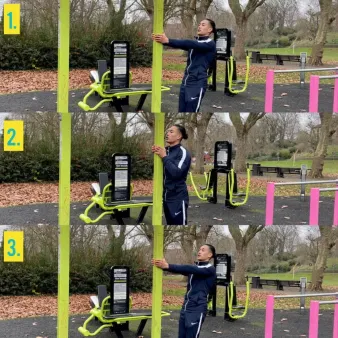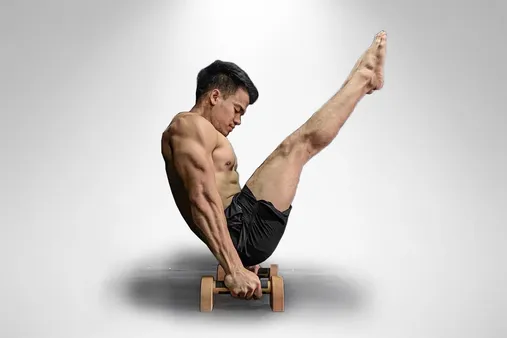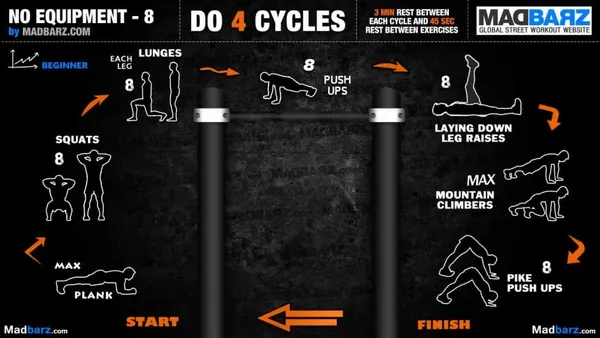Table of Contents
Calisthenics is a great way to get in shape without having to go to the gym. It's a bodyweight training method that uses your own body weight as resistance. This makes it a very accessible and affordable way to get fit. If you're new to calisthenics, you may be wondering where to start. In this article, we'll give you a beginner's guide to calisthenics, including tips on how to get started, what exercises to do, and how to progress safely. Whether you're a complete beginner or you've been doing calisthenics for a while, you'll find something useful in this article. So what are you waiting for? Get started with calisthenics today and see how quickly you can transform your body!
Where to Start with Calisthenics: A Comprehensive Guide for Beginners
I. Key Concepts about Calisthenics
Topic | Key Takeaway |
|---|---|
Benefits | |
Equipment | |
Exercises | |
Frequency and Duration | |
Nutrition and Recovery | |
Mistakes to Avoid |
II. Where to Start with Calisthenics: A Comprehensive Guide
Understanding the Benefits: A Path to Improved Fitness
Calisthenics, a form of bodyweight training, has gained immense popularity for its accessibility and effectiveness in enhancing fitness levels. Engaging in calisthenics exercises can lead to a myriad of benefits, including improved muscular strength, enhanced flexibility and mobility, and overall cardiovascular health. Embarking on a calisthenics journey can significantly contribute to your physical well-being and propel you towards achieving your fitness goals.Numerous studies have consistently demonstrated the positive impact of calisthenics on muscle development. Calisthenics exercises, which often involve compound movements, effectively target multiple muscle groups simultaneously. This holistic approach to training promotes balanced muscle development, leading to increased strength and improved functional fitness. Incorporating calisthenics into your fitness regimen can transform your physique, enhancing muscle definition and overall athleticism.
Essential Bodyweight Exercises for Beginners: A Foundation for Progress
Venturing into the world of calisthenics requires a solid foundation of basic bodyweight exercises. These fundamental movements serve as the building blocks for more advanced calisthenics skills and provide a platform for gradual progression. Embracing a beginner-friendly approach is paramount to ensuring a safe and enjoyable calisthenics journey.Push-ups, a cornerstone of calisthenics, effectively target the chest, triceps, and shoulders. Start by performing push-ups on your knees if the traditional form proves challenging initially. Squats, another indispensable exercise, engage the quadriceps, hamstrings, and glutes. Lunges, a variation of squats, focus on unilateral leg development, enhancing balance and coordination. Gradually increase the repetitions and sets of these exercises as you gain strength and stamina.
Exercise | Targeted Muscle Groups |
|---|---|
Push-ups | Chest, triceps, shoulders |
Squats | Quadriceps, hamstrings, glutes |
Lunges | Unilateral leg development, balance, coordination |
Building a Calisthenics Routine: A Tailored Approach to Progress
Crafting a calisthenics routine that aligns with your fitness goals and capabilities is crucial for sustained progress. Begin with 2-3 calisthenics sessions per week, each lasting 20-30 minutes. as you become more comfortable with the exercises, gradually increase the frequency and duration of your workouts. Active rest periods between sets, such as light jogging or dynamic stretching, can enhance recovery and prepare your body for the next exercise.When designing your calisthenics routine, incorporate a variety of exercises that target different muscle groups. This comprehensive approach ensures balanced development and minimizes the risk of muscular imbalances. Focus on compound exercises that engage multiple muscle groups simultaneously, maximizing efficiency and promoting overall fitness.
Tips for Progressing Safely and Effectively: A Path to Mastery
Embarking on a calisthenics journey requires dedication, consistency, and a commitment to proper technique. To ensure safety and maximize progress, follow these essential tips:- Prioritize proper form over the number of repetitions. Maintaining good form protects your joints and muscles from injury, setting the foundation for long-term progress.- Listen to your body and rest when needed. Overtraining can lead to burnout, plateaus, and potential injuries. Respect your body's limits and allow for adequate recovery time between workouts.- Incorporate warm-ups and cool-downs into your routine. Warming up prepares your body for the upcoming workout, reducing the risk of injuries. Cooling down promotes recovery and reduces muscle soreness.- Enjoy the process and set realistic goals. Calisthenics is a journey, not a sprint. Embrace the challenges, celebrate your progress, and focus on gradual improvement rather than immediate results.
Where to Start with Calisthenics: A Comprehensive Guide
III. Essential Bodyweight Exercises for Beginners
As a fitness beginner, it is crucial to start with exercises that promote proper form and minimize the risk of injury. Calisthenics offers a wide range of exercises that are suitable for individuals of all fitness levels. These exercises can be performed anywhere, without the need for specialized equipment.
To kickstart your calisthenics journey, focus on bodyweight exercises that target major muscle groups and promote overall fitness. Push-ups are an excellent choice as they engage the chest, shoulders, and triceps. Squats work the glutes, quads, and hamstrings, while lunges target the legs and glutes. These exercises provide a solid foundation and help improve strength and mobility.
Exercise | Targeted Areas |
|---|---|
Push-ups | Chest, shoulders, triceps |
Squats | Glutes, quads, hamstrings |
Lunges | Legs, glutes |
Advanced Calisthenics Exercises for Strength and Flexibility
Once you've mastered the basic bodyweight exercises, you can gradually introduce advanced calisthenics exercises. These exercises challenge your strength, flexibility, and coordination. Handstands, for instance, engage the entire body and enhance balance and stability. Pull-ups target the back and biceps, promoting upper body strength. Dips work the triceps, chest, and shoulders, contributing to muscular development.
Advanced calisthenics exercises require proper form and technique to prevent injuries. It's essential to progress at your pace and practice regularly to improve your skills. If you're new to calisthenics, consider working with an experienced instructor or joining a calisthenics community.
Circuit Training for Enhanced Calisthenics
Circuit training is a great way to elevate your calisthenics workouts and maximize efficiency. It involves performing a series of exercises without rest, transitioning from one exercise to the next. Circuit training improves cardiovascular fitness, muscular endurance, and agility.
When creating a circuit training routine, choose exercises that target different muscle groups. Start with a warm-up exercise, such as jumping jacks or high knees. Follow with exercises like push-ups, squats, lunges, and pull-ups. Perform each exercise for a specific amount of time or repetitions, and rest for a short period before moving on to the next exercise.
As you progress in your calisthenics journey, you'll discover a wide range of exercises and techniques to keep your workouts challenging and fun. Remember to prioritize proper form, practice regularly, and listen to your body to avoid injuries. With persistence and dedication, you'll achieve your fitness goals and unlock your full potential in calisthenics.
Essential Bodyweight Exercises for Beginners
IV. Building a Calisthenics Routine
Start with a Solid Foundation
Building a calisthenics routine requires a solid foundation. Begin with basic exercises like push-ups, squats, and lunges. These exercises target multiple muscle groups and help develop overall strength and mobility. Gradually increase the difficulty by incorporating variations and progressions as you progress.
Remember to warm up before each workout and cool down afterward. This helps prepare your body for the exercises and reduces the risk of injuries. Listen to your body and rest when needed. Consistency is key, so aim for 2-3 sessions per week, for 20-30 minutes per session.
Incorporate Variety and Balance
To ensure balanced development, incorporate exercises for different body parts. Include exercises that target the upper body, lower body, and core. This will help you develop a well-rounded physique and improve overall fitness.
Don't be afraid to try new exercises and challenge yourself. As you progress, gradually increase the frequency and duration of your workouts. However, avoid overtraining and give your body adequate rest to recover and rebuild.
Related Posts:
- How to Do a Muscle Up
- The Best Calisthenics Gifts and Accessories
- The Best Calisthenics Quotes and Motivation
Exercise | Benefits |
|---|---|
Push-ups | Upper body strength, chest, triceps |
Squats | Lower body strength, quads, glutes |
Lunges | Lower body strength, quads, hamstrings |
Building a Calisthenics Routine
V. Tips for Progressing Safely and Effectively
Keep realistic expectations, and don't try to do too much too soon. It takes time and effort to see results, so be patient and consistent with your training.
Listen to your body and take breaks when you need them. Don't push yourself too hard, and if you experience any pain, stop exercising and consult with a doctor or physiotherapist.
Warm up before each workout and cool down afterward. This will help to prevent injuries and improve your flexibility.
Use proper form when performing exercises. This will help to maximize the benefits of the exercises and reduce the risk of injuries.
Start with a few reps of each exercise and gradually increase the number of reps as you get stronger.
Incorporate rest days into your workout routine to give your muscles time to recover.
How to Build Muscle and Strength with Calisthenics
Don't be afraid to experiment with different exercises and find what works best for you.
VI. Related Posts
VII. Benefits of Calisthenics
Benefit | Description |
|---|---|
Improved fitness | Calisthenics can help you improve your overall fitness, including your strength, endurance, flexibility, and balance. |
Increased muscle strength | Calisthenics exercises can help you build muscle strength and tone your body. |
Enhanced flexibility and mobility | Calisthenics exercises can help you improve your flexibility and mobility, which can reduce your risk of injuries and improve your overall quality of life. |
Tips for Progressing Safely and Effectively
VIII. Conclusion
Calisthenics is a great way to get in shape and improve your overall fitness. It's a versatile form of exercise that can be done anywhere, anytime. If you're new to calisthenics, start slowly and gradually increase the difficulty of your workouts over time. With consistency and dedication, you'll be amazed at how much progress you can make. So what are you waiting for? Get started with calisthenics today and see for yourself how transformative it can be!